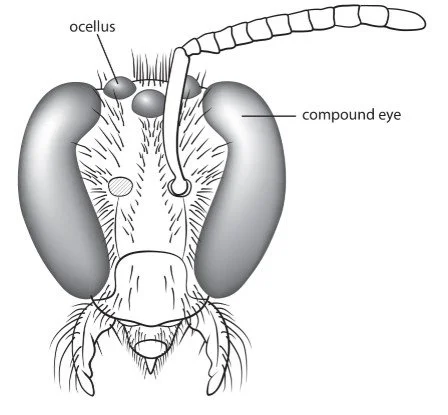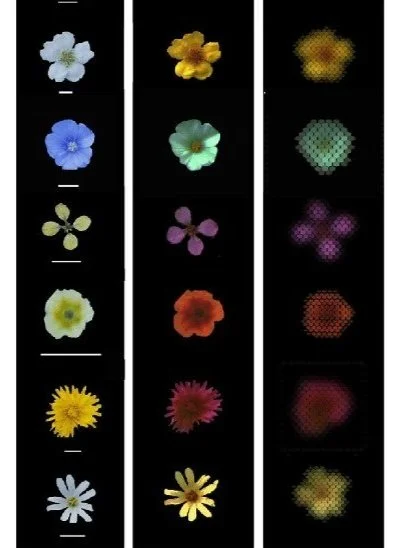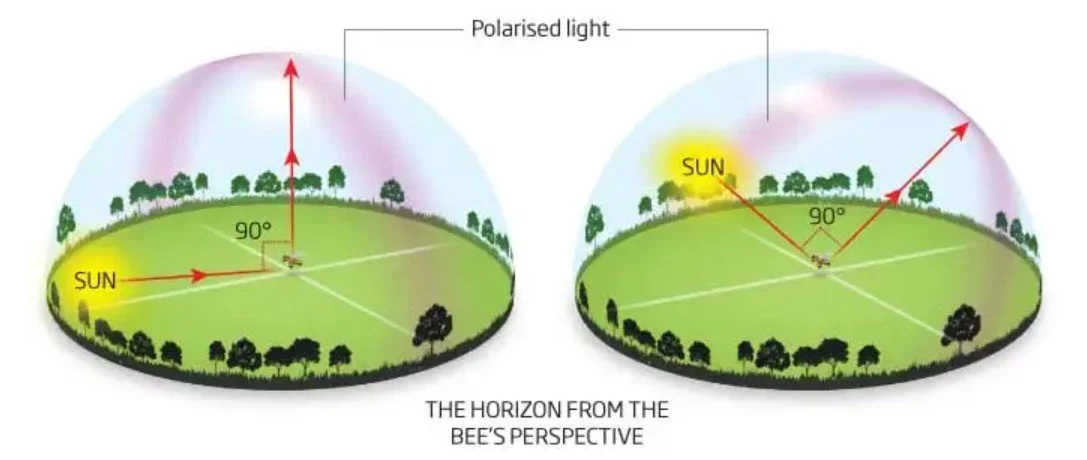Honey Bee Sensory Superpowers: Sight
Honey bees have highly specialized vision that allows them to see the world in ways fundamentally different from humans. Their compound eyes, made up of thousands of tiny facets (lenses), enable them to detect color, movement, and even ultraviolet light. Their enhanced vision plays a crucial role in their ability to locate flowers for pollination, especially with the help of iridescent and UV patterns that guide them to the nectar source. In this blog, we’ll explore how honey bees see the world outside their hives, and how their exceptional visual abilities support their vital role in nature.
Two Compound Eyes
A honey bee's compound eyes are made up of thousands of tiny facets, each capturing a small part of its surroundings. Each facet connects to a small tube called an ommatidium, which contains a lens, visual cells, and pigment cells that help separate it from neighboring facets. These facets work together, and the bee’s brain processes the individual images into a mosaic-like view of the world.
The colors humans and bees see depend on how pigment cells absorb and reflect light—some wavelengths are absorbed while others bounce back. Humans have three types of cone cells in their eyes, each sensitive to a different range of light wavelengths—red, green, and blue. These combine in varying intensities, allowing us to perceive a full spectrum of colors. Bees perceive color through specialized light-sensitive cells within their ommatidia. Four of these cells detect yellow-green light, two respond to blue, and one is sensitive to ultraviolet. Because they lack a receptor for red, it appears black to them, though they can detect reddish hues like yellow and orange. Their light wavelength sensitivity has blue-green, blue, violet, and a unique color called "bee’s purple," which combines yellow and ultraviolet light—making it invisible to humans. It is believed that bees are most attracted to shades of purple, violet, and blue.
This enhanced color perception helps bees locate flowers for pollination. Flowers use their vivid colors to attract pollinators, often making their petals a different, more vibrant color than the leaves. Many flowers also have ultraviolet patterns, invisible to humans, that guide bees toward the nectar.
Additionally, some flowers exhibit UV iridescence, where their petals appear to shift color depending on the angle of light. To bees, this creates quick flashes between colors, making the petals look like glowing, inviting signals. These iridescent patterns often accentuate the nectar source at the center of the flower, serving as a landing board for all pollinators.
The photo on the left should look familiar, as that is how the human eye and brain would process this flower’s colors. The photo on the right is how the same flower appears to a honey bee.
Bees also process color significantly faster than humans—the fastest of any known animal—at a rate five times quicker than ours. This sharp perception allows them to distinguish individual flowers in a cluster with ease, particularly when they are actively flying! By detecting subtle color changes and UV patterns, bees efficiently locate nectar sources mid flight, increasing their pollination success and benefiting the plants they visit.
The left column shows how humans perceive flower colors, while the middle column represents the colors visible to a honey bee. The right column provides a more accurate depiction of how a honeybee’s compound eye processes the image.
A honeybee’s compound eye consists of numerous ommatidia arranged in a lattice, creating a mosaic-like, hexagonal pattern. While some have speculated that this visual structure influences the hexagonal shape of honeycomb, research suggests the two are unrelated. (For more on honey bee wax, check out our previous blog, Bees at Work: The Wonders of Wax.)
Three Ocelli
Honey bees also have three ocelli, which are simple eyes with a single lens. Unlike compound eyes, ocelli don’t form images but help bees detect the direction and intensity of sunlight. These specialized navigation tools enable bees to orient themselves and return to their hive after foraging or going on mating flights.
Honey bees rely on polarized light to navigate outside their hive. The Rayleigh Sky Model explains Rayleigh scattering, where light interacts with air molecules, water, dust, and other aerosols, creating distinct polarization patterns in the sky. To a honey bee, these patterns manifest as a band that dynamically shifts with the movement of the sun throughout the day, acting as a GPS to guide them home.
Beekeepers often observe "orientation flights" when introducing hives to new locations. As bees emerge for the first time in a new hive location, they fly in circular patterns facing the hive entrance, mapping their surroundings using polarized sunlight. This behavior allows them to program their hive’s location and ensures they can find their way back after foraging.
Different Castes Have Different Eye Purposes
Queen bees and male drones share the same five-eye structure as worker bees, but they use their compound eyes for different purposes. While all three castes rely on ocelli for navigation, drones and queens have specialized visual adaptations for reproduction.
During her mating flight, the queen travels to a "drone congregation area," a dense cloud of drones from multiple colonies. Drones have a single purpose outside the hive—finding a queen to mate with in this whizzing cloud of charged chaos. To aid in this, their compound eyes are significantly larger than those of workers and queens, allowing them to spot a queen more easily within the congregation area.
Although a queen’s compound eyes are smaller than a drone’s, she still relies on them for navigation, mating, and returning to the hive after her flight(s).
Darkness in the Hive
While this post has so far focused on what honey bees see outside the hive, it's just as important to consider what they see inside—and the short answer is: nothing! The hive is completely dark unless it’s being inspected by a beekeeper.
So how do bees navigate, build wax, communicate, care for brood, and store honey (among many other indoor tasks) without sight? Maybe they have a form of communication in the darkness that humans haven’t figured out yet—perhaps some secret night vision goggles!? As far as we know, they rely on their other senses—touch, smell, and even specialized signals like pheromones and bee dances. Stay tuned for future blog posts where we’ll dive deeper into these other honey bee senses!
Sources:
https://www.researchgate.net/figure/Flowers-as-seen-through-honeybee-eyes-The-figure-shows-displays-human-colours-of_fig3_262342869
https://www.beeculture.com/bees-see-matters/
https://badbeekeepingblog.com/2016/06/28/the-bees-sixth-sense/








